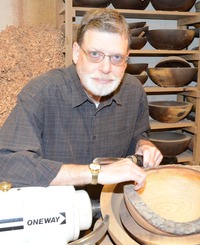I live in mid-Michigan between Saginaw and Flint. My education includes a technical degree in photography, an AAS in Music, a BA in Math Education and an MA in Technology. I have taught Jr. High, High School, Adult Ed, and College; mostly mathematics. I have also operated my own photography business, worked in retail and sweated in a factory.
As far back as I can remember I cut and split wood with my dad and my brother. Little did I know what this repetitive process would teach me about visualizing what was inside the log. My father started making furniture as a hobby by the time I was in Jr. High. I can still remember the smell of the saw dust and the feelings of gratification when a project was completed.
My first introduction to woodturning came while visiting an art exhibit that displayed lathe turned wood objects. I was intrigued. Over the next few months I familiarized myself with all that was involved in turning wood. Then early in 2002 I purchased my first wood lathe. As soon as I started turning I was hooked, immediately. The next year was spent focusing on tool technique and familiarizing myself with the turning process. I read books, watched videos of some great turners and spent endless hours on the lathe. Then in 2003 I attended David Ellsworth's School of Woodturning where I studied tools, technique and design for turning bowls and hollow forms. In 2010 I had the opportunity to take private lessons from Ernie Conover after receiving a scholarship for his Master Spindle Turning class. Learning from both David and Ernie were great experiences.
I see woodturning as a subtractive process in that all of the material and form for the end product is already present inside the log. The turner transforms an ordinary log into something new and different by taking away everything that is not needed and leaving the rest. You can literally watch this process unfold before your eyes. What is latent in the log becomes actualized in the final form. Initially, the design of the finished piece must be conceived in the mind of the turner and visualized in the log. It is then the task of the woodturner to shear away, or subtract, every part of the log that does not conform to the initially conceived design. As a turner I am often faced with unanticipated obstacles in the wood. These pleasant surprises add character to the piece being turned.
Turning wood is a great artistic release. It is also addictive.

